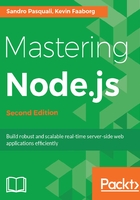
Objects and arrays
As we learned when investigating numbers, V8 works best when your code is predictable. The same holds true with arrays and objects. Nearly all of the following bad practices are bad for the simple reason that they create unpredictability.
Remember that in JavaScript, an object and an array are very similar under the hood (resulting in strange rules that provide no end of material for those poking fun at the language!). We won't be discussing those differences, only the important similarities, specifically in terms of how both these data constructs benefit from similar optimization techniques.
Avoid mixing types in arrays. It is always better to have a consistent data type, such as all integers or all strings. As well, avoid changing types in arrays, or in property assignments after initialization if possible. V8 creates blueprints of objects by creating hidden classes to track types, and when those types change the optimization, blueprints will be destroyed and rebuilt—if you're lucky. Visit https://github.com/v8/v8/wiki/Design%20Elements for more information.
Don't create arrays with gaps, such as the following:
let a = [];
a[2] = 'foo';
a[23] = 'bar';
Sparse arrays are bad for this reason: V8 can either use a very efficient linear storage strategy to store (and access) your array data, or it can use a hash table (which is much slower). If your array is sparse, V8 must choose the least efficient of the two. For the same reason, always start your arrays at the zero index. As well, do not ever use delete to remove elements from an array. You are simply inserting an undefined value at that position, which is just another way of creating a sparse array. Similarly, be careful about populating an array with empty values—ensure that the external data you are pushing into an array is not incomplete.
Try not to preallocate large arrays—grow as you go. Similarly, do not preallocate an array and then exceed that size. You always want to avoid spooking V8 into turning your array into a hash table. V8 creates a new hidden class whenever a new property is added to an object constructor. Try to avoid adding properties after an object is instantiated. Initialize all members in constructor functions in the same order. Same properties + same order = same object.
Remember that JavaScript is a dynamic language that allows object (and object prototype) modifications after instantiation. Since the shape and volume of an object can, therefore, be altered after the fact, how does V8 allocate memory for objects? It makes some reasonable assumptions. After a set number of objects are instantiated from a given constructor (I believe 8 is the trigger amount), the largest of these is assumed to be of the maximum size, and all further instances are allocated that amount of memory (and the initial objects are similarly resized). A total of 32 fast property slots, inclusive, are then allocated to each instance based on this assumed maximum size. Any extra properties are slotted into a (slower) overflow property array, which can be resized to accommodate any further new properties.
With objects, as with arrays, try to define as much as possible the shape of your data structures in a futureproof manner, with a set number of properties, of types, and so on.